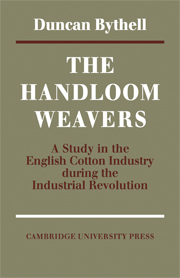Book contents
- Frontmatter
- Contents
- Preface
- Introduction
- Map of the weaving towns and villages of north-east Lancashire in 1821
- 1 Problems and sources
- 2 The organization of the industry
- 3 The labour force
- 4 The coming of the powerloom
- 5 Wages: (I) The piece-rate
- 6 Wages: (II) Earnings and the standard of living
- 7 Public opinion and the handloom weavers
- 8 Organized industrial action among the cotton handloom weavers
- 9 The weavers and radical politics
- 10 The problem of poverty
- 11 Displacement and disappearance
- Appendix 1 Some piece-rate series
- Appendix 2 The piece-rate and the price of food
- Appendix 3 G. H. Wood's estimates of average weekly earnings
- Bibliography
- Index
9 - The weavers and radical politics
Published online by Cambridge University Press: 07 October 2011
- Frontmatter
- Contents
- Preface
- Introduction
- Map of the weaving towns and villages of north-east Lancashire in 1821
- 1 Problems and sources
- 2 The organization of the industry
- 3 The labour force
- 4 The coming of the powerloom
- 5 Wages: (I) The piece-rate
- 6 Wages: (II) Earnings and the standard of living
- 7 Public opinion and the handloom weavers
- 8 Organized industrial action among the cotton handloom weavers
- 9 The weavers and radical politics
- 10 The problem of poverty
- 11 Displacement and disappearance
- Appendix 1 Some piece-rate series
- Appendix 2 The piece-rate and the price of food
- Appendix 3 G. H. Wood's estimates of average weekly earnings
- Bibliography
- Index
Summary
When soliciting parliamentary assistance and applying industrial pressure on their employers had proved ineffective or inappropriate, there was always open to the handloom weavers a third method of halting the decline in their well-being. This was to seek the reconstruction of the institutions of the country—if not, indeed, of the very structure of society—in order to end the evils which had seemed inseparable from the old system of government. The discontented in the early nineteenth century did not lack radical social and political doctrines which they might espouse. In concrete terms, these doctrines usually involved the complete overhaul of the electoral system of Great Britain so as to give free and direct representation in the legislature to all elements in the community, and the end of all legislation which favoured any one class in society at the expense of the rest.
Once the handloom weavers were in full decline after 1826, their connexion with radical politics of this kind became a commonplace both to contemporaries and to many subsequent historians; it was contrasted particularly with their alleged loyalism in past times of prosperity. Old men looking back from the unhappy 1830s were very prone to lament the weakening of loyalty to old institutions.
- Type
- Chapter
- Information
- The Handloom Weavers , pp. 205 - 232Publisher: Cambridge University PressPrint publication year: 1969

